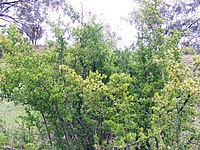
Photo from wikipedia
BackgroundLycii Cortex (LyC), composed of Lycium chinense and Lycium barbarum cortex and having the Chinese name Digupi, is used to treat chronic diseases like cough, hypertension, and diabetes in Eastern… Click to show full abstract
BackgroundLycii Cortex (LyC), composed of Lycium chinense and Lycium barbarum cortex and having the Chinese name Digupi, is used to treat chronic diseases like cough, hypertension, and diabetes in Eastern Asia. However, chromatographic methods, such as TLC and HPLC, to determine the phytochemical composition of LyC have not been included in any official compendiums. This study aims to establish a validated HPLC method for quality control of LyC.MethodsKukoamines A and B (KA and KB, respectively) were selected as markers for the HPLC method. An acetic acid solution was adopted for sample extraction because it facilitated the release of kukoamines and effectively prevented their degradation. Optimal separation of the kukoamine isomers was achieved on hydrophilic ligand-coated C18 columns with a gradient elution of acetonitrile and 0.1% (v/v) trifluoroacetic acid. The average contents and proposed contents for LyC were calculated with a t test and an uncertainty test based on 16 batches of authentic samples.ResultsThe method was validated with linearity (r2 = 0.9999 for both KA and KB), precision (RSD = 1.29% for KA and 0.57% for KB), repeatability (RSD = 1.81% for KA and 0.92% for KB), and accuracy (recovery of 90.03–102.30% for KA, and 98.49–101.67% for KB), indicating that the method could offer reliable results for quality control analysis of LyC. At the 95% confidence level, the calculated content limits were 1.45 mg/g for KA and 4.72 mg/g for KB.ConclusionCompared with conventional morphological identification, the HPLC method involving KA and KB contents offers precise, objective, and quantitative results for quality control of LyC.
Journal Title: Chinese Medicine
Year Published: 2017
Link to full text (if available)
Share on Social Media: Sign Up to like & get
recommendations!